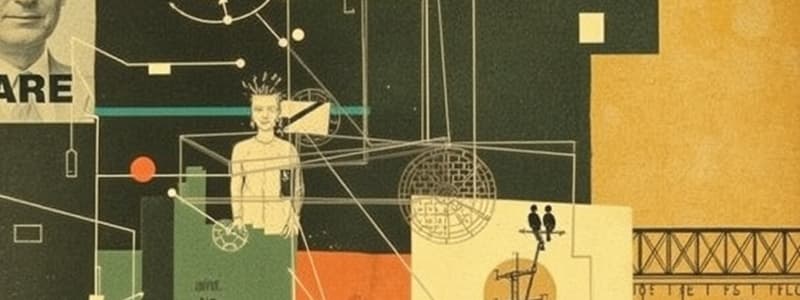Podcast
Questions and Answers
What does TCP/IP stand for?
What does TCP/IP stand for?
- Transmission Control Process/Internet Protocol
- Transmission Control Protocol/Internet Protocol (correct)
- Transmission Communication Process/Internet Protocol
- Technical Control Program/Internet Protocol
Which layer is responsible for routing protocols such as RIP and OSPF?
Which layer is responsible for routing protocols such as RIP and OSPF?
- Application layer
- Transport layer
- Host to Host layer
- Internet layer (correct)
What is the primary goal of the TCP three-way handshake?
What is the primary goal of the TCP three-way handshake?
- To establish a secure channel
- To initiate a connection (correct)
- To encrypt data packets
- To terminate an existing connection
Which of the following layers combines the functions of the application, presentation, and session layers?
Which of the following layers combines the functions of the application, presentation, and session layers?
What does the acronym DOD stand for in the context of TCP/IP?
What does the acronym DOD stand for in the context of TCP/IP?
What is the main purpose of the Checksum field in a data segment?
What is the main purpose of the Checksum field in a data segment?
Which of the following protocols operates at the Network Access Layer?
Which of the following protocols operates at the Network Access Layer?
What is the purpose of the Source port number in a segment?
What is the purpose of the Source port number in a segment?
What type of address is used for routed protocols such as IP?
What type of address is used for routed protocols such as IP?
Which field confirms the total number of segments received by the receiver?
Which field confirms the total number of segments received by the receiver?
What is the range of values for port numbers in a segment?
What is the range of values for port numbers in a segment?
Which protocol can be classified under WAN protocols?
Which protocol can be classified under WAN protocols?
What does the Sequence number field in a segment help with?
What does the Sequence number field in a segment help with?
What is the purpose of the sixth field in TCP?
What is the purpose of the sixth field in TCP?
What does the 'R' symbol in TCP flags represent?
What does the 'R' symbol in TCP flags represent?
How is the checksum verified in TCP communication?
How is the checksum verified in TCP communication?
What does an urgent pointer signify in TCP?
What does an urgent pointer signify in TCP?
What is the function of the Destination Address (DA) in packet transmission?
What is the function of the Destination Address (DA) in packet transmission?
What does the Start of Frame Delimiter (SOF) allow the receiving device to do?
What does the Start of Frame Delimiter (SOF) allow the receiving device to do?
What is the format of the Source Address (SA) in packet transmission?
What is the format of the Source Address (SA) in packet transmission?
What is the length of the flags field in TCP?
What is the length of the flags field in TCP?
What does the Frame Check Sequence (FCS) field store?
What does the Frame Check Sequence (FCS) field store?
What problem is associated with ring topology networks?
What problem is associated with ring topology networks?
Which of the following correctly represents a field in an Ethernet frame?
Which of the following correctly represents a field in an Ethernet frame?
What is a characteristic of Ethernet's media-access method?
What is a characteristic of Ethernet's media-access method?
How many devices can be connected to one MAU in a token ring network?
How many devices can be connected to one MAU in a token ring network?
What is a major disadvantage of token ring networks?
What is a major disadvantage of token ring networks?
What type of cables can be used in ARC-net according to IEEE 802.5?
What type of cables can be used in ARC-net according to IEEE 802.5?
In the context of networking, what does the term 'token passing' refer to?
In the context of networking, what does the term 'token passing' refer to?
What is a collision domain in Ethernet networking?
What is a collision domain in Ethernet networking?
What method does Ethernet use to help devices share bandwidth without collisions?
What method does Ethernet use to help devices share bandwidth without collisions?
What type of topology connects computers to a central device with individual cables?
What type of topology connects computers to a central device with individual cables?
What is a significant advantage of star topology over bus topology?
What is a significant advantage of star topology over bus topology?
What happens when two devices transmit at the same time in a collision domain?
What happens when two devices transmit at the same time in a collision domain?
Which devices can prevent a transmission from propagating throughout the entire Ethernet network?
Which devices can prevent a transmission from propagating throughout the entire Ethernet network?
What is the effect of collisions on network performance?
What is the effect of collisions on network performance?
What typically represents a single collision domain in a network?
What typically represents a single collision domain in a network?
Flashcards are hidden until you start studying
Study Notes
Introduction
- TCP/IP (Transmission Control Protocol/Internet Protocol) is a fundamental protocol suite used for communication on the Internet and intranets.
- TCP/IP is based on the Department of Defense (DOD) model.
IP (Internet Protocol)
- IP is a network layer protocol responsible for addressing and routing data packets across networks.
- IP defines a logical addressing scheme (IP addresses) for devices.
- Examples of network layer protocols: RIP, OSPF, EIGRP, IS-IS
- Examples of routed protocols: IP, Apple Talk, IPX (Internetwork Packet Exchange)
- Examples of message and control protocols: ICMP (Internet Control Message Protocol), Error Message, Ping, Traceroute
- ARP (Address Resolution Protocol) is used to translate logical IP addresses to physical MAC addresses.
TCP (Transmission Control Protocol)
- TCP provides reliable and ordered delivery of data segments.
- TCP uses a three-way handshake to establish a connection between two devices.
OSI (Open Systems Interconnection) Model & TCP/IP Relationship
- The OSI model is a theoretical framework that defines seven layers of network communication.
- TCP/IP maps to the OSI model but does not strictly follow all its layers.
Network Access Layer
- The Network Access Layer is responsible for the physical transmission of data over a network medium.
- Examples of LAN protocols: Ethernet, Token Ring, ARC-NET
- Examples of WAN protocols: HDLC, PPP, ISDN, Frame Relay, ATM
- MAC addresses are physical addresses that uniquely identifies a device on a network.
- The Network Access Layer converts binary data into signals suitable for the network media.
TCP Segment Header Fields
- Source port number: Specifies the port number of the sending device.
- Destination port number: Specifies the port number of the receiving device.
- Total Length: Indicates the total length of the TCP segment (header + data).
- Checksum: Ensures data integrity during transmission by performing an arithmetic operation on the segment.
TCP Segment Header Fields for Connection Management
- Sequence number: Identifies individual data segments and facilitates in order delivery.
- Acknowledgment number: Confirms receipt of segments from the sender.
- DO: Shows the size of the TCP header.
- RSV: Reserved field for future use.
- Flags: Control bits that manage the connection state and data transfer.
- Window: Specifies the allowed number of segments that can be sent without acknowledgment.
Ethernet Frame Structure
- Preamble: Contains a synchronization pattern that allows the receiver to identify the start of a frame.
- Start of Frame Delimiter (SOF)/Synch: Marks the beginning of the frame.
- Destination Address (DA): 48-bit MAC address of the intended recipient.
- Source Address (SA): 48-bit MAC address of the transmitting device.
- Length or Type: Specifies the total length of the frame or indicates the upper layer protocol.
- Data: Data payload from the Network layer.
- Frame Check Sequence (FCS): CRC value used for error detection.
Token Ring Network
- Devices in a token ring network are connected in a closed loop, creating a circular path for data transmission.
- A special token circulates around the ring.
- A device can transfer data only when it possesses the token.
ARC-NET
- A token passing network, using UTP or fiber optic cables.
Ethernet Network
- Ethernet uses a contention-based media access method called Carrier Sense Multiple Access with Collision Detection (CSMA/CD).
- Devices share the same bandwidth.
- Collisions can occur when multiple devices attempt to transmit simultaneously.
- Collision domains are network segments where a collision can occur.
- Broadcast domains are network segments where broadcasts can reach all devices.
Star Topology
- Devices are connected to a central hub, switch, or access point.
- Offers better fault tolerance compared to bus topology.
- Offers easier troubleshooting.
Studying That Suits You
Use AI to generate personalized quizzes and flashcards to suit your learning preferences.




